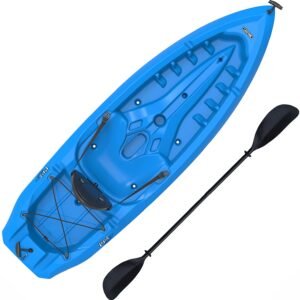Pregnancy can hugely change your life. What has been alright for you may no longer be such, and you will need to do things that you’ve never done before. For those 9 months and a few weeks after delivery, your lifestyle will need to be changed.
Does this mean that you will need to pause your kayaking hobby? Or can you kayak when pregnant? Let’s try to find an answer to this question.
Can you kayak when pregnant?
So can you kayak when pregnant?
Kayaking is a fairly low-impact activity, so women with normal pregnancies, in general, shouldn’t have issues while kayaking.
With that being said, there are many intricacies that should be kept in mind by pregnant women. While kayaking is a relatively safe and low-intensity activity, it can have its own threats. Let’s overview this issue a little more in-depth so that you know what we mean.
What are the challenges of pregnancy for kayaking?
During pregnancy, your needs and habits aren’t the same anymore – hormonal changes causing mood swings and rapid shits in your dietary needs leave a severe impact on your physical abilities. In particular:
- Your muscles may stretch and lose their strength.
- You may gain weight due to the dietary and hormonal changes.
- You will need some getting used to your new shape or size.
Not only that, your kayak may put forth its own limits. For example, if you have a sit-in kayak and if you prefer to skirt it, then your belly may make things less convenient for you.
Your added weight may also be a problem, depending on how much weight you’ve added and the weight capacity of your kayak.
Morning sickness and general fatigue will likely also severely limit you. Even light rocking of the kayak may cause seasickness in you, and you may not have as rapid reactions to what is happening in the water.
Lastly, you may suddenly feel bad while kayaking, so you will need to take additional precautions before and during the trip.
Whether or not you will be able to kayak depends on how you feel and what you want. If you feel good and want to kayak, then go ahead and do it! But do remember to consult your doctor so that they determine whether your pregnancy allows for boating. They will also be able to give you tips specific to your condition.
Safety precautions for pregnant women
Now, if your doctor does determine that kayaking will be safe for you, then here are 4 tips that you should follow while kayaking during your pregnancy.
Do not kayak alone
First and foremost, take a paddle buddy with you. In fact, paddle with someone experienced – you may feel bad, lose consciousness, or otherwise get physically impaired, and your companion needs to be able to react quickly and save you.
Kayak only in calm water in not too hot weather
The second big tip to follow is to kayak only in calm water.
First of all, there will be less rocking in the water, so it will be less likely for you to feel sick while kayaking.
Secondly, the risk of capsizing is less likely during kayaking. Capsizing is stressful, and the impact with the water may negatively affect the fetus. Not only that, on cooler days, capsizing can lead to hypothermia or cold shock.
Also, do not paddle in hot and humid weather. Heat and humidity can stress your body, which is a thing that you do not want.
Avoid whitewater kayaking
Whitewater kayaking is fun and competitive, but it’s a high-impact activity that involves a significantly increased risk of capsizing, collisions, falling, etc. Needless to say, these cannot have a positive impact on you and the fetus. We’d suggest that you avoid whitewater kayaking altogether.
Pay close attention to your body
Finally, pay attention to how you feel during the trip. If you feel any unusual pain, dizziness, or weakness, end your trip immediately and have your buddy help you get to the shore. Make sure to note all the symptoms that your doctor has told about so that you know where to ring the alarm.
What should be generally avoided during pregnancy?
Our answer to “can you kayak when pregnant?” isn’t full without some backing by science.
We’d like to focus on more general guidelines on exercise during pregnancy. They will be a little beyond kayaking, but there are a few things that you should keep in mind.
A paper titled Guidelines for Physical Activity during Pregnancy: Comparisons From Around the World contains some interesting data in regard to exercise during pregnancy. There is a lot of information to take in from this paper, and we encourage that you have a look at it.
Pay special attention to the tables with lists of contraindications, activities to avoid, symptoms to look out for, and so on.
We’ll introduce you to a few bits of knowledge from the study so that you have an idea of what you are dealing with.
Contraindications to exercise during pregnancy
Some of the overviewed countries divide contraindications into absolute and relative, where the former refers to cases when exercise is not recommended and the latter refers to conditions where the risks may exceed the benefits.
Among absolute contraindications are:
- Abnormal amniotic fluid.
- Persistent bleeding.
- Diabetes mellitus.
- Fetal abnormalities.
- Fetal growth restriction.
- History of miscarriage, preterm birth, or/and preterm labor.
- Poorly controlled hypertonia.
- Acute infections.
- Multiple gestation (twins or higher).
Among relative contraindications are:
- Anemia.
- Arrhythmia.
- Chronic bronchitis.
- Mild to moderate cardiovascular disorders.
- Eating disorders.
- History of extremely sedentary lifestyle.
- Multiple gestation (twins or higher, in some countries).
Activities to avoid
The paper also covers what activities should be avoided during pregnancy. Exercise should not involve:
- Abdominal pressure or trauma.
- Altitude.
- Contact or collision.
- Excessive body heat.
- Excessive joint stress.
- Falls.
- Hot or humid weather.
- High impact.
- Motionless standing.
- Lying on the back.
Signs and symptoms to look out for
Finally, of interest to us are signs and symptoms whose occurrence means that you should end the exercise. Among those are:
- Abdominal pain.
- Amniotic fluid leakage.
- Calf pain or swelling.
- Chest pain.
- Decreased fetal movement.
- Dizziness.
- Fatigue.
- Headache.
- General pain.
- Muscle weakness.
- Excessive shortness of breath.
- Pelvic pain.
- Uterine contractions.
- Vaginal bleeding.
Keep in mind that your doctor should inform you about all the precautions and signs or symptoms that you will need to look out for.
Do not rely on what you find on Google – no one will be able to provide you with tips specific to your condition. Only your doctor can do that. Educate yourself online only to get a general idea of how you should approach kayaking or other exercise types during pregnancy.
Bottom line
So can you kayak when pregnant?
Your condition will determine whether you should kayak or not. If you have a normal pregnancy, do not have a history of miscarriage, preterm labor or birth, and other medical conditions, then it is likely that your doctor will allow you to kayak.
In this case, we suggest that you read our post on kayaking safety tips.
If not, then you can’t do anything about it – the only option is to wait until you deliver and fully recover from your pregnancy.
In the end, no matter what you or your doctor decide, make informative decisions and stay safe!


